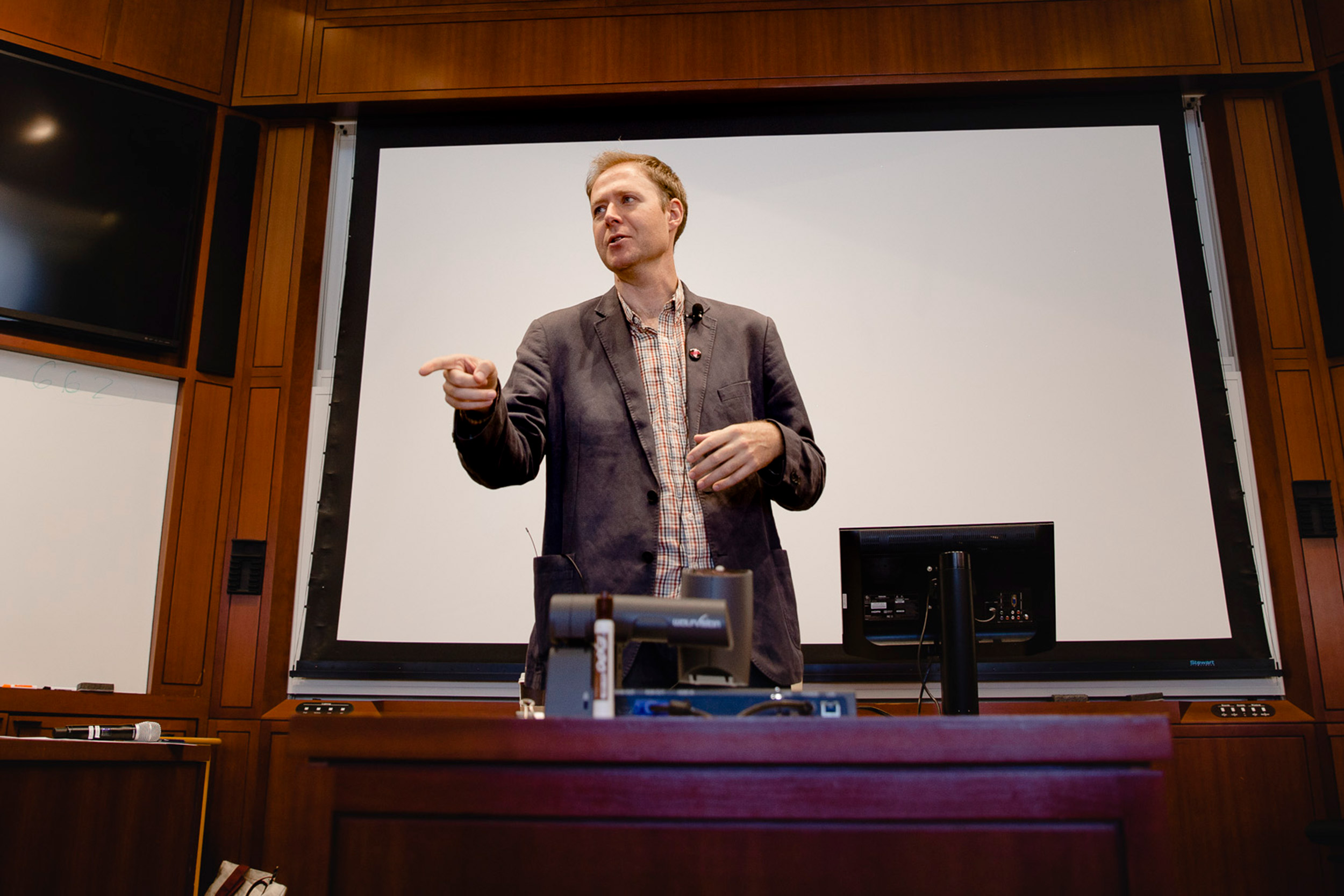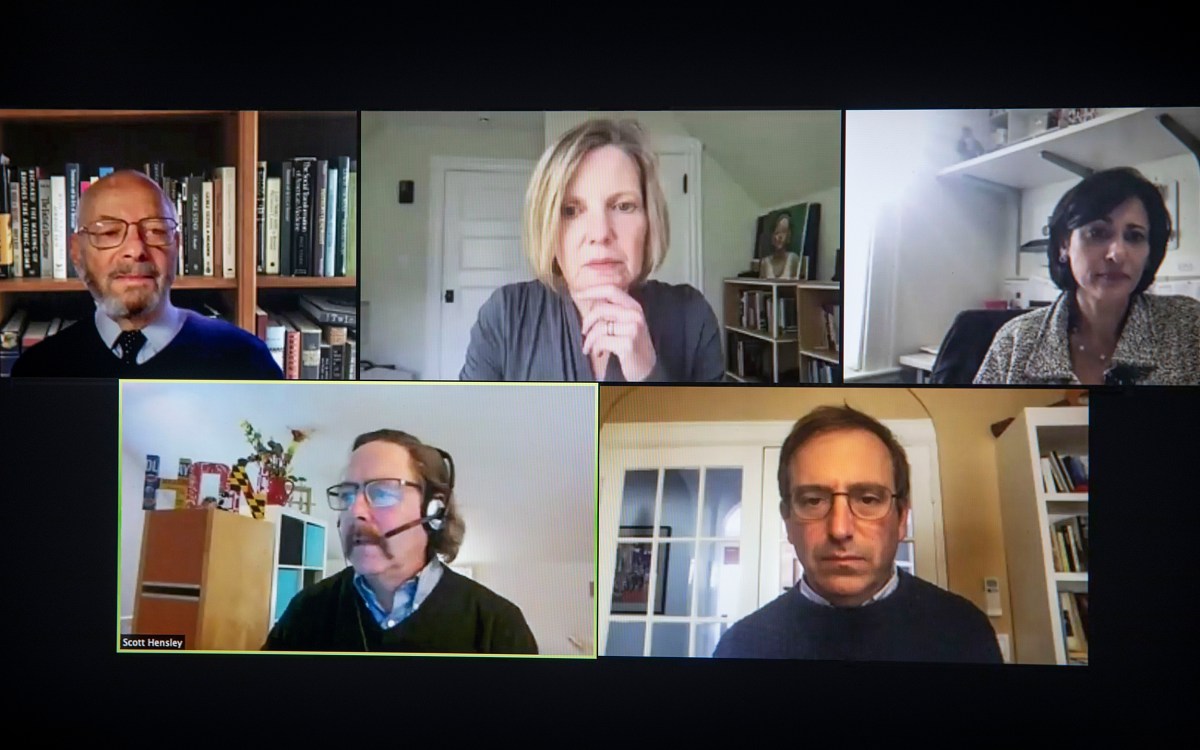
David Eaves, a lecturer of public policy at Harvard Kennedy School and an expert on information technology and the government, offers an overview of why governments struggle to implement technology.
Photo by Raychel Casey
So why did the state vaccine-reservation system crash?
Looking at the particular challenges the government faces with digital projects
Massachusetts’s COVID 19 vaccine appointment portal crashed on Thursday, as hundreds of thousands of residents became newly eligible to reserve the already highly coveted slots. Across the commonwealth, frustrated residents reacted with a question: Why didn’t the state anticipate and prevent this? (The sentiment was echoed later in the day by a chagrined Gov. Charlie Baker in an interview with WGBH radio.) The Ash Center sat down with David Eaves, a lecturer of public policy at Harvard Kennedy School and an expert on information technology and the government, to discuss why governments seemingly struggle to implement tech tools such as vaccine appointments or health insurance enrollment.
Q&A
David Eaves
ASH CENTER: When Massachusetts’ vaccine appointment portal crashed as a wave of newly eligible residents flocked to schedule their COVID vaccinations, did you think this was a predictable outcome?
EAVES: Predictable is probably not fair, but this outcome is more common than one would think. A big part of the challenge is we’re now in the era of digital government, where every service you launch will have a digital component to it. The capabilities to build and launch those types of services digitally are not straightforward for organizations that have been around for a period of time — but they are now core to what the government does.
ASH CENTER: Why then does government have such a tough time with technology given that it is central to how it interacts with and provides services to citizens?
EAVES: We’ve been working with digital technologies in government for 50, 60 years now, longer if you want to go far enough back. In those very early days the uses were principally military in nature. When digital technologies first penetrated the government — outside of research and more in operations — it was around back-office systems like automating payroll, solving complex problems, storing large quantities of information like the census, etc. They weren’t systems that citizens — or even really many public servants — touched to deliver services or do transactional work in a direct way. That started to shift later with the arrival of terminals, then desktop computers, and then really accelerated with the arrival of the web over the last two decades. It’s the web that has likely most shifted expectation among citizens, that services should be instantaneous and available to them 24/7 online.
Each of these shifts in technology often requires new and different skills and competencies. And the technology is more diffuse, touching more people in the government than historically. And changing processes and re-skilling people to adapt to that era is not something that happens overnight — particularly in a large organization that is optimized for stability.
“… it’s easy to pick on government. The truth is all sorts of organizations struggle with this work.”
ASH CENTER: But we’re almost eight years after the failed launch of healthcare.gov, and it seems that government still hasn’t learned its lesson about managing these large technology rollouts. Why do you think that is?
EAVES: Well, one simple reality is that it’s hard, and it’s easy to pick on government. The truth is all sorts of organizations struggle with this work. Innumerable private companies have failed to use digital technologies — think Kodak (which actually played a role in inventing digital photography). We just don’t talk about these companies because … they don’t exist anymore! Even among newcomers, just the other day I recall Google Docs stopped working and a vast quantity of the workforce was like … “What do we do?” They’re one of the most preeminent technology firms on the planet, and they’re not flawless. They have moments where things don’t work out for them. I like to remind people that even mature digital organizations have these moments.
What is particularly challenging is that government is still wrestling to acquire the new skills and processes the organization needs to launch a service. It’s hard shifting a large organization, with established legacy processes from a paper-based era, and job descriptions and titles and ways of doing the work that are all pre-digital. That’s no small task to turn around and transform — particularly as it won’t get you many votes.
And of course add in the urgency of COVID vaccinations, which likely meant things were rushed. I can imagine many state vaccine portals haven’t been through normal purchasing channels, because [doing so would have meant] you had to scope out the website and put in a request for proposals [RFPs], which can easily be an 18-month process — well before the first case of COVID was discovered.
Then there’s a whole bunch of constraints that we, the public, place on government agencies. Constraints, when viewed in isolation, such as ensuring a fair and equitable RFP process, help maintain honesty and integrity, but they also force agencies to adhere to a whole bunch of rigid rules. There are also the privacy rules unique to government that are also important but complicate the rollout of these sorts of initiatives and are not a challenge the private sector always has to deal with.
All this sounds like an apology. It isn’t. The government should be able to stand up a site like this. These are table-stakes problems in a digital era. Having worked with governments I also have empathy to just how hard this shift is. And … the public should demand, and receive, better service.
ASH CENTER: What steps could Massachusetts or other governments take in the future as they continue to roll out their vaccination sign-up portals to broader numbers of residents?
EAVES: Last year I had Mikey Dickerson, the gentleman who led the rescue team for healthcare.gov, visit my class and discuss what’s become known as the Dickerson Triangle of Service Reliability, which is kind of a Maslow’s Hierarchy of Needs for technology projects. His point is you have to start at the bottom and get these things right.
He talked about showing up to support the healthcare.gov website during the crises and focusing his energy on putting out fires, but more importantly rolling out infrastructure to help you understand what was going wrong and where it was going wrong. And then once you had monitoring in place, you had to have some sort of incident-response process. And then you want to do like a root-cause analysis to prevent similar problems in the future. So you work your way out the hierarchy of needs. A really good engineering team is starting at the bottom working their way up.
However, a senior public administrator is sitting at the top of this pyramid looking down. And most of the time they see only the tip of that pyramid, which is the final product. If you have a really, really gifted politician or administrator, they’ll look two layers down. Getting them to care and invest in what is happening at the bottom of that Dickerson Triangle is hard. And building and standardizing those processes is hard. But that’s the type of uninteresting and politically boring work that is needed at the leadership level.
We have to recognize that this is frustrating for the people of Massachusetts. And it’s not like anybody at the state of Massachusetts wanted this to happen. And a bunch of people are working really hard to stand up a website in very short order for a process that is relatively unique and new. We need to demand better. And there should be accountability, but there should also be empathy.
Interview was lightly edited for clarity and length.






